Blog Article Conversion Rates in Blog Marketing: Generate more leads with blogs

Blog articles primarily help customers in the information phase of the purchasing decision-making process. But what if you want to generate leads directly with blog marketing in this phase? This is possible, but only with low conversion rates of a good 0.1% to 0.5%.
Blog articles create massive reach of organic clicks on search engines. In online marketing, they are primarily used to pick up the user in the information phase of a purchase decision-making process. This in turn increases the likelihood of a purchase and can increase deal volume. Users who know you and have a lot of contact with your content are more likely to complete a target action than completely new users, for whom you are initially just one provider among many. The more touchpoints a lead has with your content, the statistically more qualified they are to make a purchase or to purchase the next higher offer.
Blog articles feed primarily on information-oriented keywords
But why are blog articles primarily important in the information phase and only secondarily in direct lead generation? The background is that blog articles get their high reach from search engine traffic primarily through information- oriented search engine keywords . This means that there are a large number of possible combinations of search terms and specialist topics because certain facets in a specific search term combination have not yet been covered by a competitor. In addition, information-oriented keywords are not as heavily contested – both in the organic and in the paid area, precisely because they do not convert as much, i.e. fewer conversions (target actions)trigger on the website. As a result, blog articles generate a lot of clicks, thereby boosting the indexing strength of the entire website, and pick up users especially in the information phase – but they have low conversion rates in the area of direct lead generation. Some examples of information-oriented keywords would be: [target groups google analytics], [target groups ga4] or [speculation tax real estate].
On the other hand, there are interaction-oriented keywords that indicate a purchase or action intention . These are usually very competitive , both organic and paid. Google Ads click prices are typically much higher than for industry, information-centric keywords. However, it is also the case that most inquiries are generated via interaction-oriented keywords and these have the highest conversion rates . Examples of such interaction-based keywords would be: [google analytics agency], [buy a condominium in grunewald] or [real estate valuation in Berlin].
But if I still want to generate leads with blog articles - which conversion rate is realistic?
A conversion rate indicates what percentage of clicks from Google Ads or organic Google searches led to a target action , i.e. a conversion. Such target actions can be: Submitted contact forms, purchases, tracked calls or downloads. These can be measured, for example, via Google Analytics, directly via Google Ads, via Google Tag Manager, Adobe Analytics or Matomo.
For blog articles, a realistic conversion rate across all industries is around 0.1% to 0.5%. An average blog article conversion rate of 0.5% is already very good . Compared to other advertising media in online marketing, this is a relatively low conversion rate. For high-priced and complex topics, such as B2B or real estate, landing page conversion rates of around 1% – 3% are the norm, in some cases even a little over 4%. In gastronomy and delivery services, conversion rates for online orders and calls can even be a good 20% – 25%.
This means: blog article conversion rates are significantly lower due to the traffic from information-oriented than the conversion rates from interaction-oriented, conversion-optimized landing pages with the corresponding keywords that aim at a purchase or action intention. Ultimately, this also means that for a lead gained from a blog article, at best with a conversion rate of 0.5%, arithmetically 200 user clicks from organic Google search or Google Ads are required. With a blog article conversion rate of 0.1%, there would even be 1,000 user clicksnecessary to generate a single lead. Mind you, this only works if a sufficient number of call-to-action sections are built into the blog articles and tested so that the user is also called upon to make a purchase, register or make a phone call. If there are no call-to-action sections in the blog article, hardly any leads are likely to be generated directly from the blog article.
Example of a strong conversion rate of blog articles in blog marketing
But what do the reference values say? As explained, a blog article conversion rate of a good 0.1% to 0.5% cannot compete with a B2B landing page that has a conversion rate of 1% to 3%. Below is an example of a relatively good blog article conversion rate of around 0.5%. The goal achieved (conversion) in this case is the achievement of a thank you page after submitting a contact form. Accordingly, the blog article that contained the contact form is the previous page path before reaching the thank you page. We see here: Even blog articles that already contain many call-to-action sections and contact forms achieve a conversion rate of around 0.5%.
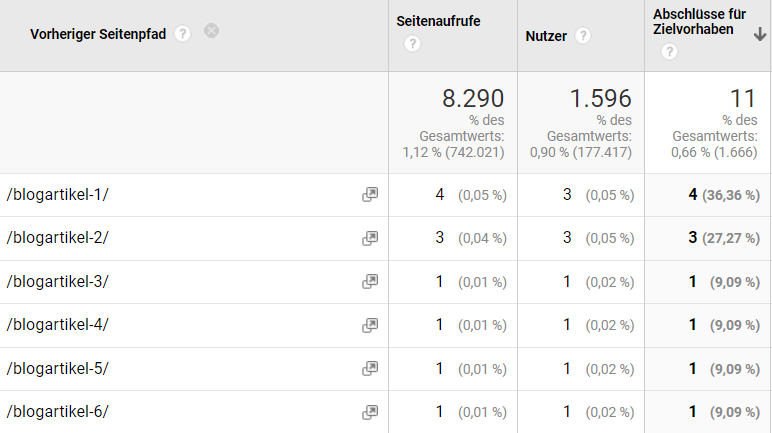
Example of a high conversion rate of blog articles in Blog Marketing (viewed in Google Analytics).
Example: Rather moderate blog article conversion rate in blog marketing
However, it doesn’t always have to be like this. In the second website example, the blog article conversion rate is rather moderate at 0.38% . In any case, this means: You really need a large number of readers for your blog articles so that they trigger a conversion.
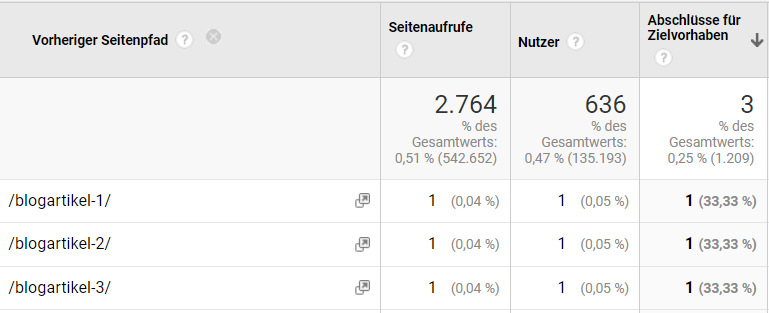
This is what a rather modest blog article conversion rate of 0.38% looks like (viewed in Google Analytics).
Examples of call-to-action sections in blog marketing
But which call-to-action sections should you include so that your conversion rate in blog marketing tends to be 0.5% instead of 0.1%? There are basically three types of call-to-action sections in blog articles:
- Call-to-action in the head info box
- Call to action in the in-text box
- Call to action in the sidebar box
- Call-to-action contact form
Below are some examples of how these call-to-action sections can be presented in blog marketing. In the end, however, it is up to the free design. A big advantage of many blog article call-to-action sections used is not only the increase in the conversion rate, but the possibility of using them as additional carrier elements for frequently searched keywords with a high search volume. Here you can also add the relevant keywords that your blog article is focused on. Ideally, this further improves your blog article search engine indexing – and without leaving a negative design impression because of the frequent use of the same keyword embedded in the overall picture of the article.
Call-to-action in the head info box in blog marketing
The head section of your blog article is the first important way to let the reader know that they can take an action on the site. This can contain a direct topic reference to the blog article – or an indirect one.
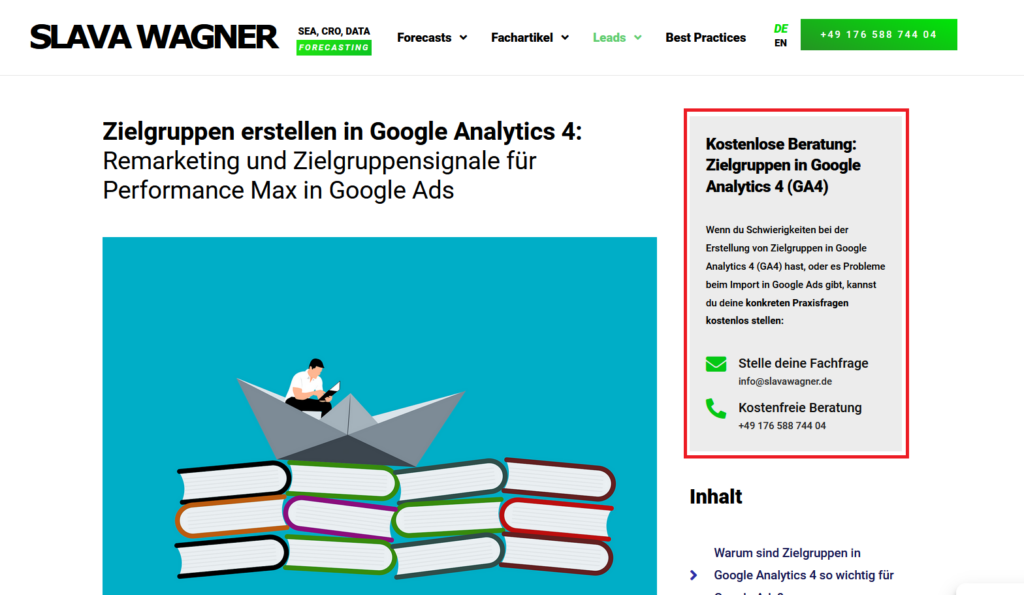
The head area of a blog article is well suited for integrating a call-to-action section in blog marketing to increase the conversion rate of the blog article.
Call-to-action in the in-text box in blog marketing
If a reader is already engrossed in the content of your blog article, a good opportunity would be to include themed in-text call-to-action sections so that either action is taken directly or at least the reader knows that they are on the website with its possible contact request is definitely welcome. This will take away some of the reader’s fear and anxiety while also improving your blog post’s conversion rate.
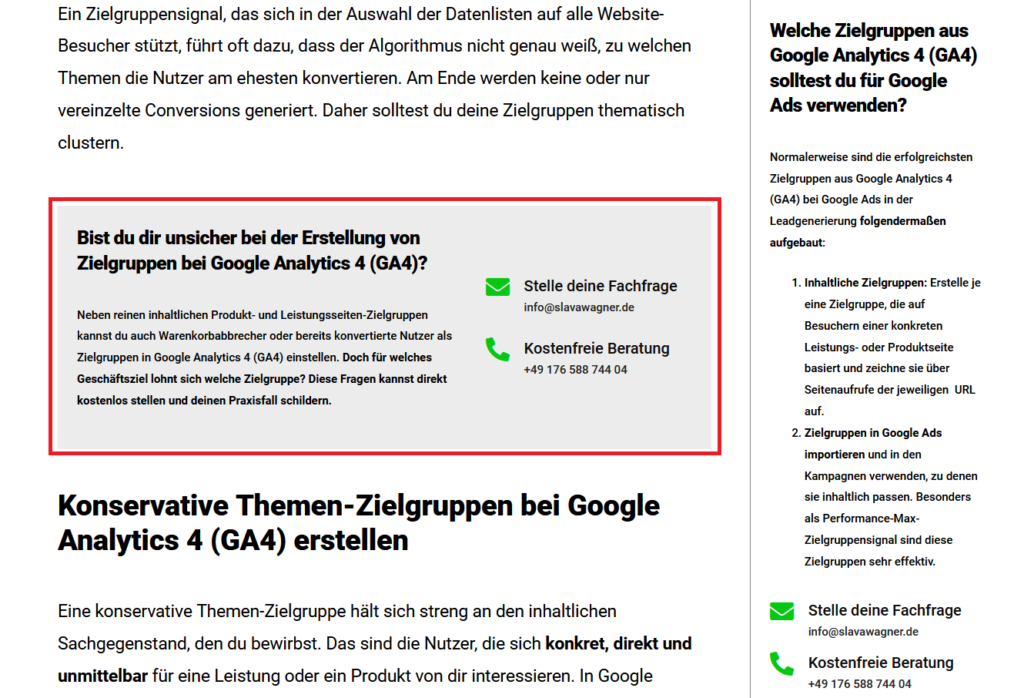
Include one or more call-to-action sections in the in-text of a blog post to boost blog marketing conversions.
Call-to-action in the sidebar box in Blog Marketing
A call-to-action section in the sidebar of a blog article is another structurally important opportunity to increase conversion rates and engage with the reader. You can also let the call-to-action element in the sidebar scroll along with long blog articles. With Elementor on WordPress websites, for example, you can use the EAC Components plugin.
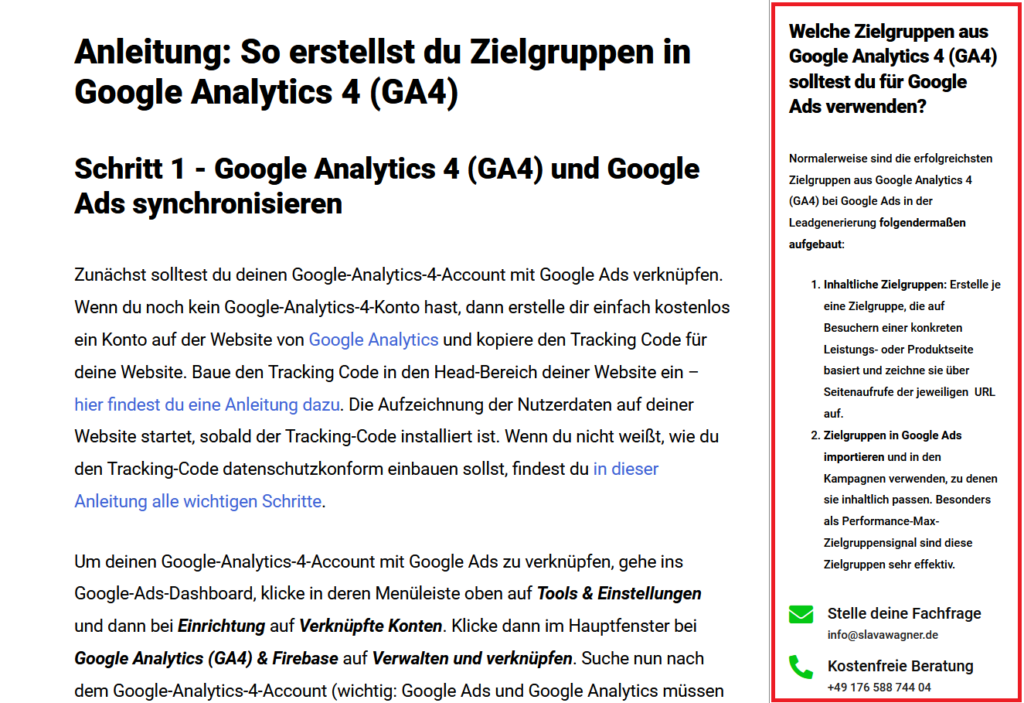
You can also include a call-to-action section in the blog post sidebar if you want to get even more conversions from blog marketing.
Call-to-action contact form in blog marketing
In addition to the options to write emails or make phone calls, you should also give readers the opportunity to register directly with a contact form. Not everyone likes to call, and not everyone likes to email. Therefore, it is good to use all contact options so that every reader of the blog article has an easy time to interact, make an inquiry or sign up for something.
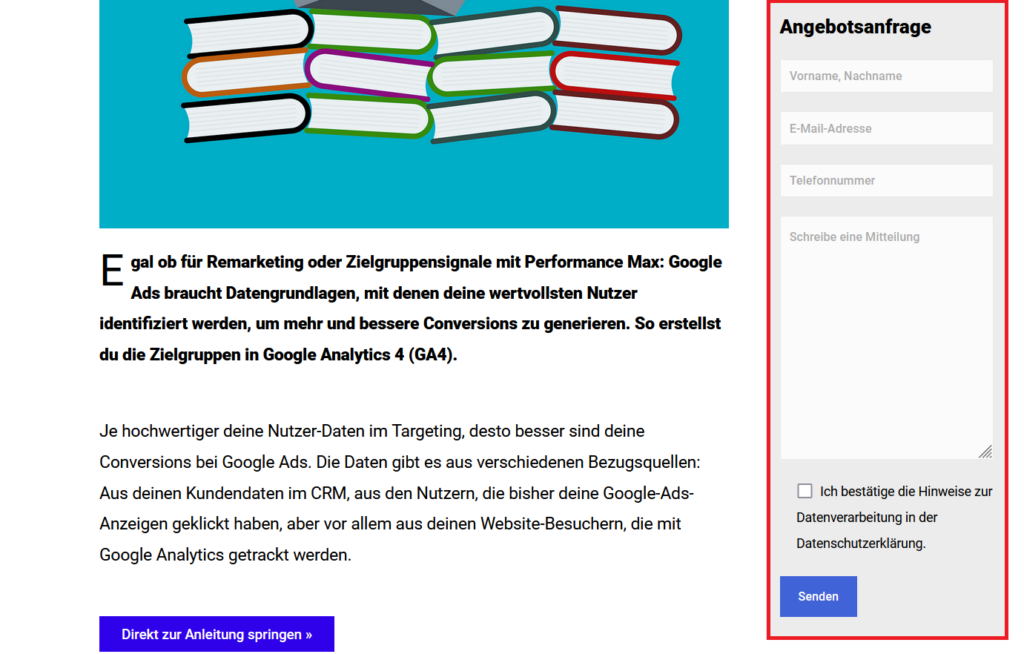
The contact form should not be missing as an additional interaction option in the blog article in order to set the conversion rate in blog marketing even higher. This can be built in as a call-to-action section in the head area, in the sidebar or in the in-text.
Conclusion in blog marketing: Huge number of clicks with low conversion rates in direct lead generation
Blog marketing should be a must for anyone who does not yet have high online reach and does not spend a large advertising budget on ads campaigns. A large number of high-reach blog articles is the base, the foundation and the launch pad for your SEO success. Of course, a conversion-optimized landing page with a focus on interaction-based keywords has a higher conversion rate than a blog article – but if you don’t already have a relevant organic reach, the probability that you will achieve success on extremely competitive, niche, interaction-based keywords is vanishingly small . In this case, it is unlikely to generate even single clicks.
Blog articles, on the other hand, always give you the opportunity to integrate a large number of keywords with a few A4 pages of text and to place the focus keyword 40 to 70 times so that you quickly get good ranking positions and clicks. The reason for this is that information-oriented keywords are googled much more often than rare, technical keywords that contain a purchase intention. This makes blog articles the safest and most reliable way to sustainably generate clicks and leads from organic traffic. Although blog articles have lower conversion rates than classic, conversion-optimized landing pages, they reliably bring leads through the sheer mass of users reached and qualify later customers much more strongly, as part of the information phase in a purchase decision-making process.
Above all, the higher the organic reach, the more likely it is that you will be able to rank better with competitive, interaction-based keywords on conversion-optimized landing pages. A website that generates 20,000 organic Google clicks per month has a better chance of quickly being indexed to the top than a freshly hosted domain with a new website – without great backlinks, without technical factors, without organic clicks and impressions.
Many companies want to take off quickly in the field of SEO – but usually without a rocket and without a launch pad. In this example, the rocket would be a performance page in the form of a conversion-optimized landing page with competitive, interaction-oriented keywords. But the launch pad would be the high organic reach through blog marketing. So construct the launch pad first before making a rocket take off.
Blog article conversion rates
If you have any questions regarding this blog article, feel free to ask:
Ask your question
info@slavawagner.de
Overview
- Blog articles feed primarily on information-oriented keywords
- But if I still want to generate leads with blog articles - which conversion rate is realistic?
- Example of a strong conversion rate of blog articles in blog marketing
- Example: Rather moderate blog article conversion rate in blog marketing
- Examples of call-to-action sections in blog marketing
- Call-to-action in the head info box in blog marketing
- Call-to-action in the in-text box in blog marketing
- Call-to-action in the sidebar box in Blog Marketing
- Call-to-action contact form in blog marketing
- Conclusion in blog marketing: Huge number of clicks and huge reach with low conversion rates in direct lead generation
Conversion rates in blog marketing
Blog articles are a very good way to generate a lot of organic clicks. The reason for this is that they can transport a wide range of information-oriented keywords for Google searches due to their length and quality of content. Information-oriented keywords are much less competitive than interaction-oriented keywords, which indicate an intention to buy or to take action.
However, this also means that the conversion rate in blog articles is effectively 0.1% to 0.5% lower than in classic sales landing pages for high-priced products with 1% to 3% (sometimes more).
Ask your question
info@slavawagner.de
Why do blog articles with organic traffic often have a conversion rate of 0.1% to 0.5%?
There are various reasons why blog articles that generate organic clicks from Google search often only have a conversion rate of around 0.1% to 0.5%. First of all, many blog article readers often have no specific purchase interest or are not yet ready to make a purchase decision, but they are only looking for information on a specific specialist topic . A confusing or not user-friendly website can also lead to a lower conversion rate. In order to increase the conversion rate, the content, the stringency of the keyword integration for the rankings in the organic Google search, and the user-friendliness of the website should be optimized.
FAQ - Summary of blog article conversion rates in Blog Marketing
Here is a summary of important and frequently asked questions about blog article conversion rates:
Blog articles generate high organic reach – due to the presence of many technical, information-oriented keywords. At the same time, these are also the reason why blog articles often only have conversion rates of 0.1% to 0.5%: The users have an information intention and no interaction intention. With an interaction-oriented, conversion-optimized landing page advertised with Google Ads, you therefore have conversion rates of 1% to 3% or more, while blog articles have lower conversion rates, also due to their UX structure.
If you want to increase your conversion rate on blog articles to generate more leads, you should include a series of call-to-action sections. Pay attention to the diversity and unobtrusiveness of the sections, as the user is not too aggressively distracted from reading the blog article content: So use a head info box at the top of the blog article on the side, with calls to action, your contact email and Phone number to prompt the user to take action directly on this page. Then build several in-text boxes with call-to-action content in the body copy, spaced a few paragraphs apart. You can also place a call-to-action section in the sidebar of the blog article, which optionally scrolls automatically.
Conversion rates of 0.1% to 0.5% are realistic for blog articles, as their primary purpose is to provide information. As a rule, blog readers do not come with the aim of making a purchase, but rather to find out more or to be entertained. Conversion rates of 1% or higher are more likely to be expected from specific landing pages or sales pages that are specifically targeted for conversion. It’s important to keep expectations realistic and measure a blog post’s success not only by conversion rate, but also by other factors such as traffic, engagement, and brand awareness.
Blog articles often have a high number of organic clicks from Google searches because they provide relevant and informative content that search engines rank as high quality. By using relevant keywords and search terms in the text as well as an optimized structure and formatting, blog articles can also be crawled and indexed better by search engines, which leads to higher visibility in the search results. Also, people tend to see blogs as a trustworthy source of information, which can result in a higher click-through rate.
You might also be interested in:
Schema markups for FAQ questions: More clicks from organic Google search
To have a chance get into the related questions section at the top of Google Search, you can set up your answered questions with FAQ schema markup.
How to install the AMP integration on WordPress websites according to GDPR
With the AMP integration you can get up to 25% more organic impressions in search engines on your website.

